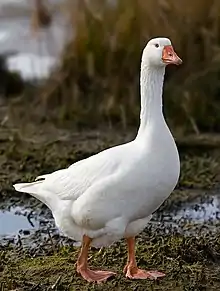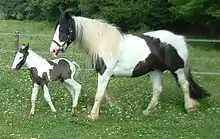Reconstruction:Proto-Turkic/kāŕ
Proto-Turkic
Alternative reconstructions
- *kāz
Etymology
Considering the bird’s black feathers, it could be a derivative of the word 'black' (see Proto-Turkic *kara), but most data support the hypothesis of an onomatopoeic origin.[1][2][3] Probably related to the Hungarian onomatopoeic word gá-gá (“sound a goose makes”).[3] This onomatopoeic formation may serve the same function as other Turkic bird-related words like karga (“crow, black bird”) and kuş (“bird”), compare the Hungarian onomatopoeic word kár-kár ("to croak").[3]
Alternatively, borrowed from some reflex of Proto-Indo-European *ǵʰh₂éns (“goose”), perhaps Tocharian.[4][5] Pedersen derived from Old Armenian *գաս (*gas), the supposed earlier form of սագ (sag, “goose”),[6][7] but this derivation is implausible.[2][5] Unlikely to be a direct borrowing from Proto-Indo-European, but perhaps coincidental or a cultural Wanderwort.[8] Compare with Chechen гӏа̄з (ğaaz), Ingush гӏа̄ж (ğaaž).
Declension
| Singular 3) | |
|---|---|
| Nominative | *kāŕ |
| Accusative | *kāŕnï, *kāŕïg 4), *kāŕnïg 1) |
| Genitive | *kāŕnïŋ |
| Dative | *kāŕka |
| Locative | *kāŕta |
| Ablative | *kāŕtan |
| Allative | *kāŕgaru |
| Instrumental 2) | *kāŕïn |
| Equative 2) | *kāŕča |
| Similative 2) | *kāŕlayu |
| Comitative 2) | *kāŕlïgu |
2) The original instrumental, equative, similative & comitative cases have fallen into disuse in many modern Turkic languages.
3) Plurality is disputed in Proto-Turkic. See also the notes on the Proto-Turkic/Locative-ablative case and plurality page in Wikibooks.
4) Found in the Old Turkic era.
Descendants
- Oghur:
- Chuvash: хур (hur)
- Common Turkic:
- Oghuz:
- Karluk:
- Kipchak:
- Siberian:
- → Abkhaz: а-ҟыз (a-qʼəz)
- → Adyghe: къаз (qaz)
- → Alanic:
- → Archi: хъаз (qaz)
- → Avar: хъаз (qxaz)
- → Chechen: гӏаз (ğaz)
- → Dargwa: къаз (ɢaz)
- → Ingush: гӏаж (ğaž)
- → Kabardian: къаз (qaz)
- → Lezgi: къаз (q̄az)
- → Khowar: qoz ‘crane’
- → Persian: غاز (ğâz), قاز (qâz)
- → Pashto: قازه (qā́za)
- → Sangisari: غاز (qāz)
See also
| Animals in Turkic | |||||
|---|---|---|---|---|---|
 Dog |
dog: *ït |
 Hunting Dog |
hunting dog: *eker |
 Hen |
hen: *tiakïgu |
 Lark |
lark: *torgay |
 Pigeon |
dove, pigeon: *kȫkerčin |
 Quail |
quail: *bïldurčïn |
 Sparrow |
sparrow: *serče | .jpg.webp) Hawk |
hawk, falcon: *kïrguy |
 Goose |
goose: *kāŕ |
.jpg.webp) Wolf |
wolf: *bȫrü |
 Cow |
cow: *ingek |
 Calf |
calf: *buŕagu |
 Camel |
camel: *tebe |
.jpg.webp) Young Camel |
young of camel: *kȫĺek, *botu |
 Horse |
horse: *at |
 Foal |
foal: *kulun |
.jpg.webp) Worm |
worm: *kūrt |
 Snake |
snake: *yï̄lan |
_(4).jpg.webp) Fox |
fox: *tilkü |  goat |
goat: *keči |  He-goat |
he-goat: *teke |
_male_6y.jpg.webp) Lion |
lion: *arsïlan |
 Fish |
fish: *bālïk | Abramis brama |
carp bream: *čapak |
 Donkey |
donkey: *eĺčgek |  Carp |
carp: *siāŕgan |  Catfish |
catfish: *yāyïn |
 Beaver |
beaver: *kunduŕ |  Hedgehog |
hedgehog: *kirpi |  Badger |
badger: *borsmuk |
 Fly |
fly, mosquito: *siŋek |  Bee |
wasp, bee: *ārï | .jpg.webp) Gadlfy |
gadfly: *bȫgen |
_2.jpg.webp) Moth |
moth: *küńe |  Louse |
louse: *bït |  Earthworm |
earthworm: *sïbuĺgan |
 Yak |
yak: *kotuz |  Colt |
colt: *sïp |  Dragon |
dragon: *siāŕgan |
 Worm |
worm: *kūrt |  Deer |
deer: *keyik, *sïgun, *bulan, *bugu |  Lizard |
lizard: *keleŕ |
Further reading
- Abajev, V. I. (1973) “qaz”, in Историко-этимологический словарь осетинского языка [Historical-Etymological Dictionary of the Ossetian Language] (in Russian), volume II, Moscow and Leningrad: Academy Press, page 272
- Budagov, Lazarʹ (1871) Sravnitelʹnyj slovarʹ turecko-tatarskix narěčij [Comparative Dictionary of Turko-Tatar Dialects] (in Russian), volume II, Saint Petersburg: Imperial Academy of Sciences, page 13
- Radloff, Friedrich Wilhelm (1899) Опыт словаря тюркских наречий – Versuch eines Wörterbuches der Türk-Dialecte [Attempt at a Lexicon of the Turkic Dialects], volume II (overall work in German and Russian), Saint Petersburg: Imperial Academy of Sciences, column 360f
- Radloff, Friedrich Wilhelm (1899) Опыт словаря тюркских наречий – Versuch eines Wörterbuches der Türk-Dialecte [Attempt at a Lexicon of the Turkic Dialects], volume II (overall work in German and Russian), Saint Petersburg: Imperial Academy of Sciences, column 346
References
- Levitskaja, L. S., Dybo, A. V., Rassadin, V. I. (1997) Etimologičeskij slovarʹ tjurkskix jazykov [Etymological Dictionary of Turkic Languages] (in Russian), volume V, Moscow: Jazyki russkoj kulʹtury, page 184b
- Doerfer, Gerhard (1967) Türkische und mongolische Elemente im Neupersischen [Turkic and Mongolian Elements in New Persian] (Akademie der Wissenschaften und der Literatur: Veröffentlichungen der Orientalischen Kommission; 20) (in German), volume III, Wiesbaden: Franz Steiner Verlag, § 1389, pages 385–387
- Czeglédi, Katalin. The Nature of the Relationship between the Hungarian and Turkish Languages. Journal of Eurasian Studies. Volume IV., Issue 4. October-December 2012.
- Clauson, Gerard (1972) “”, in An Etymological Dictionary of pre-thirteenth-century Turkish, Oxford: Clarendon Press, page 679
- Ačaṙean, Hračʻeay (1979) “սագ”, in Hayerēn armatakan baṙaran [Armenian Etymological Dictionary] (in Armenian), 2nd edition, a reprint of the original 1926–1935 seven-volume edition, volume IV, Yerevan: University Press, page 152b
- Pedersen, Holger (1906) “Armenisch und die Nachbarsprachen”, in Zeitschrift für vergleichende Sprachforschung auf dem Gebiete der Indogermanischen Sprachen (in German), volume 39, number 3, pages 453–454
- Pedersen (Pedersən), Holger (1907) H. Tʻovmas Ketikean, transl., Hayerēn ew dracʻi lezunerə [Armenian and the Neighbouring Languages] (in Armenian), Vienna: Mekhitarist Press, pages 186–187
- The Proto-Bulgaro-Turkic Urheimat based on geolexical analysis (archived)